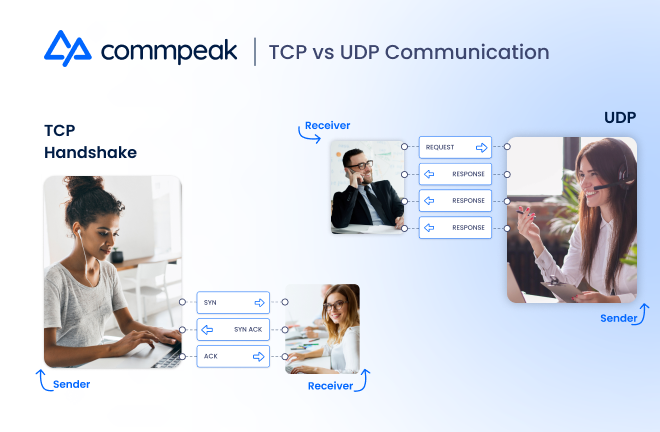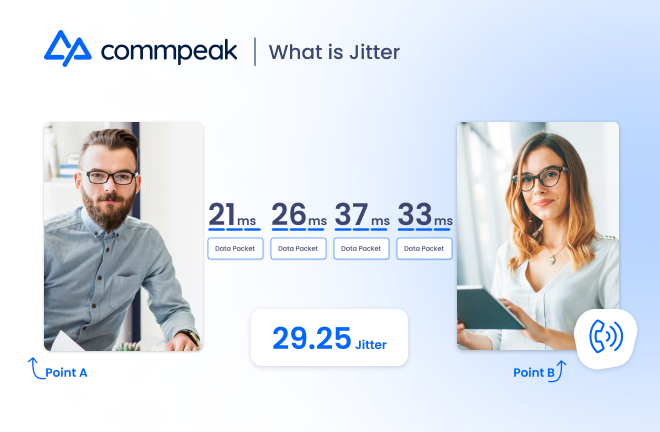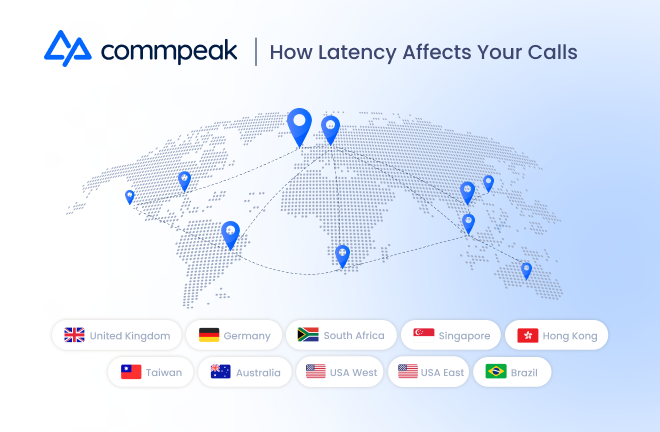VoIP technology converts your voice into multiple data packets and then relays them to your end receiver’s device as you make calls over the internet. Typically, this data travels at the speed of light, allowing you to connect with customers and speak with them in real-time. The quicker you can communicate in today’s market, the more likely you will boost profits.
Unfortunately, various issues can interfere with your connectivity speed and end up harming your business performance. Weak, overloaded networks can cause interruptions that waste significant resources. Thankfully, once you know how to assess these potential network issues, there are steps you can take to minimize them, safeguarding your call quality.
How Latency Affects Your Calls
Latency is the time it takes for data to travel from one server to another. It is measured in milliseconds (ms) and determines how long users have to wait to receive their requested information. For example, the average latency for data journeying from Western USA to Western Europe via Google’s servers is roughly 140 ms or 0.140 seconds.

The lower the latency, the less a user will have to wait for their application to load, increasing their overall experience. Conversely, when the latency gets higher, users start to become impatient and frustrated.
However, while a longer wait time might merely be an inconvenience for some internet functions, it can ultimately determine the success or failure for others like VoIP communications.
High latency for your VoIP calls can result in:
- Voice delay
- Echo
- Overlapping noises
- Talk over effect
- Lack of synchronization between voice and other media
Minimizing Latency: UDP vs. TCP
Because lower latency levels are so critical for VoIP data, the packets will typically travel via User Datagram Protocol (UDP). As opposed to TCP, which requires the receiving ‘Server B’ to acknowledge (ACK) and agree to synchronize (SYC) with ‘Server A,’ UDP eliminates the need to set up this formal, reciprocal connection. It’s precisely this connectionless behavior that lowers your latency.

Nonetheless, despite UDP’s guarantee of swifter communication, it lacks the control mechanisms and overall reliability of TCP, causing your voice packets to potentially arrive at ‘Server B’ late, out of order, or not at all. When some data packets arrive later than others, your average latency becomes inconsistent, dramatically reducing the quality of your VoIP conversations. This inconsistency is known as jitter.
What Is Jitter?
As your voice travels across the internet via UDP, the audio will break down into smaller sections that rapidly fire in succession to reach the receiver’s server. Technically speaking, jitter is the average variation in the time (or latency) it takes for these individual data packet sections to reach their destination.

Ideally, these data sections will travel at the same speed and arrive in the order your server sent them, resulting in a jitter calculation of 0 ms. Realistically, this rate will vary, but as long as your jitter remains under 30 ms, your sound quality will be relatively unaffected. Anything higher, however, runs the risk of unclear communication.
High jitter for your VoIP calls can result in:
- Choppy audio
- Garbled or jumbled audio
- Missing words or sentences
- Delayed calls
- Dropped calls
The Relationship Between Latency and Jitter
Ultimately, because jitter is a product of inconsistent latency for data packets moving between servers, you can reduce your jitter by minimizing your latency time. The less overall time it takes for this segmented data to reach your customers, the fewer chances there are of network disturbances that cause heightened variation between the individual data packets’ sending time.
Think of a competitive sprint versus a marathon. Runners’ variation in finish time will be minimal for the short sprint compared to the lengthy 26.2-mile marathon.
What Directly Causes High Jitter?
- Network Congestion: Jitter generally occurs when your IP network is overloaded with data. The congestion causes data packets to queue, delaying their arrival. This strain typically occurs when a large business only uses one ISP line for its entire operations.
- High CPU: When you have an insufficient router that wasn’t designed to support a high volume of VoIP calls (like a home router), your processing unit most likely will not be able to manage all your traffic correctly, leading to a maxed-out CPU.
- Old Hardware: If your modem, router, or switch isn’t up-to-date, it probably can’t handle your call center’s data transfer levels. A worn-out ethernet cable could also be causing audio quality issues.
- Wireless Connections: Although WiFi enables you to make VoIP calls anywhere, it’s usually a lower-quality network connection. Objects, walls, and distance can easily interfere with your connection strength and reliability.
- Incorrect VPN Endpoints: When using a VPN that virtually places you in a location other than your office network’s region, your VoIP data might have to travel through an unnecessarily distant server.
- Proxy Server Setup: Establishing a proxy server creates an additional, superfluous barrier between your VoIP calls and the end destination, increasing the chances your data packets will arrive at an inconsistent rate.
How You Can Test and Fix Your Jitter
- Examine ISP Connectivity: More often than not, jitter results from a poor internet connection. According to the FCC, your minimum download speed should be 0.5 Mbps per active VoIP calling agent. Anything less will reduce your audio quality.
- Check your network with CommPeak’s Internet Speed Test.
- If too slow, purchase a better package or upgrade providers.
- Properly Configure Router: You can set up your router to prioritize VoIP data before other types of traffic. You can also reserve a certain amount of bandwidth specifically for your calls.
- Learn more about what you can do to tailor your router for optimal VoIP quality.
- Prepare Firewall Settings: Using the correct firewall configurations guarantees that your VoIP data can pass through to your PBX server unobstructed and undelayed.
- Upgrade Your Hardware: Make sure you’re using a high-end, enterprise-grade router that can more effectively handle your VoIP traffic, especially if you regularly have a high volume of calls. Similarly, check your cable quality. Frayed and worn cables cause jitter.
- Utilize a (Properly) Wired Connection: A wired connection will always be more reliable than a wireless one when it comes to stability. Moreover, always double-check that your wires and cables are securely connected. Faulty connections can lead to jitter.
- Notify VoIP Provider of VPNs: Alert your VoIP provider if you use specific VPN endpoints or IP addresses. You will also need to mention your local office network and which countries you’ll be calling so that the provider can offer you the shortest routes.
- Eliminate Proxy Servers: VoIP traffic requires a dedicated ISP line that doesn’t have to make unneeded network hops. Do everything you can to minimize the number of requests your data needs to make.
- Use the Right-Sized PBX: Choose a PBX size that meets your operational needs accurately. If you have a higher volume of calls for your PBX than recommended, you’ll experience call quality issues.
- With CommPeak, you can get the right PBX for your business and easily upgrade it if you need more extensions.
How CommPeak Reduces Latency and Jitter
One major way to reduce latency, and therefore the potential of jitter, is to shorten the distance between end servers and eliminate any alternative data transfer routes. CommPeak’s public infrastructure, located in 10 different strategic locations worldwide, ensures that your VoIP data travels to the receiving server in the shortest, most direct way possible.

Similarly, we guarantee that we will never route your VoIP data traveling within the same region via an outside vendor. For instance, if you are in the Philippines and call Malaysia, CommPeak only connects you through vendors located in the Asia Pacific.
Experience Consistently Reliable VoIP Calls
At CommPeak, we’re committed to providing you with the highest quality VoIP services across the globe. We work with a vast network of tier 1 providers to make sure you have access to customers, regardless of where you or they are located. As a telecommunications provider, we do everything on our end to decrease your latency and jitter, leaving you free to maximize your business success.
To start experiencing clearer, interruption-free communications, sign up with CommPeak today.


